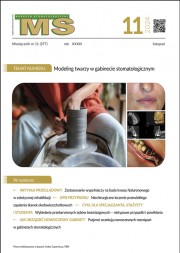Dostęp do tego artykułu jest płatny.
Zapraszamy do zakupu!
Po dokonaniu zakupu artykuł w postaci pliku PDF prześlemy bezpośrednio pod twój adres e-mail.
Recession in youth as a complication of traumatic occlusion – case description
Karolina Nikołajuk, Piotr Smołka
Streszczenie
Etiologia recesji jest wieloczynnikowa. Jedną z przyczyn może być wada zgryzu. W artykule opisano przypadek zgryzu głębokiego, którego następstwem było uszkodzenie przyzębia w odcinku przednim. Leczenie ortodontyczne u młodego pacjenta doprowadziło do eliminacji czynnika urazowego oraz poprawy stanu przyzębia.
Abstract
The aetiology of recession is caused by many factors. One of the causes may be malocclusion. The article describes the case of deep occlusion, which resulted in damage to the periodontium in the anterior segment. Orthodontic treatment of a young patient led to the elimination of the traumatic factor and improvement of the periodontal condition.
Hasła indeksowe: zgryz urazowy, zgryz głęboki, recesje dziąsłowe
Key words: occlusal trauma, deep bite, gingival recession
PIŚMIENNICTWO
1. Wolf H.F., Rateitschak E.M., Rateitschak K.H.: Periodontologia. Wydawnictwo Czelej, Lublin 2006.
2. Pietruska M., Pietruski J.: Periodontologiczno-implantologiczna chirurgia plastyczna. Wydawnictwo Czelej, Lublin 2010.
3. Dominiak M., Gedrange T.: New perspectives in the diagnostic of gingival recession. Adv. Clin. Exp. Med., 2014, 23, 6, 857-863.
4. Kassab M.M., Cohen R.E.: The etiology and prevalence of gingival recession. J. Am. Dent. Assoc., 2003, 134, 220-225.
5. Tugnait A., Clerehugh V.: Gingival recession – its significance and management. Review J. Dent., 2001, 29, 6, 381-394.
6. Akerly W.B.: Prosthodontic treatment overlap of the anterior teeth. J. Prosthet. Dent., 1977, 38, 26-34.
7. Ustun K., Sari Z., Orucoglu H. i wsp.: Severe gingival recession caused by traumatic occlusion and mucogingival stress: A case report. Eur. J. Dent., 2008, 2, 127-133.
8. Nwhator S.O.: Gingival recession in a child‑patient; easily missed etiologies: case report with video. Ann. Med. Health Sci. Res., 2014, 4, 1, 18-21.
9. Gupta N.D., Mahesgwari S., Prabhat K.C., Goyal L.: A critical review of the management of deep overbite complicated by periodontal diseases. Eur. J. Gen. Dent., 2012, 1, 2-5.
10. Wyrębek B., Orzechowska A., Cudziło D., Plakwicz P.: Evaluation of changes in the width of gingiva in children and youth. Review of literature. Dev. Period Med., 2014, 19, 2, 212-216.
11. Zimmer B., Seifi-Shirvandeh N.: Changes in gingival recession related to orthodontic treatment of traumatic deep bites in adults. J. Orofac. Orthop., 2007, 68, 232-244.
12. Slutzkey S., Levin L.: Gingival recession in young adults: occurrence, severity, and relationship to past orthodontic treatment and oral piercing. Am. J. Orthod. Dentofacial Orthop., 2008, 134, 652-656.
13. Wennström J.L., Lindhe J., Sinclair F., Thilander B.: Some periodontal tissue reactions to orthodontic tooth movement in monkeys. J. Clin. Periodontol., 1987, 14, 121-129.
14. Melsen B., Allais D.: Factors of importance for the development of dehiscences during labial movement of mandibular incisors: a restrospective study of adult orthodontic patients. Am. J. Orthod. Dentofacial Orthop., 2005, 127, 5, 552-561.
15. Alkan A., Cakmak O., Ramoglu I. i wsp.: Periodontics and orthodontics team-work in the treatment of gingival recession: Two case reports. Journal of Orthodontic Research, 2013, 1, 3, 107-112.













